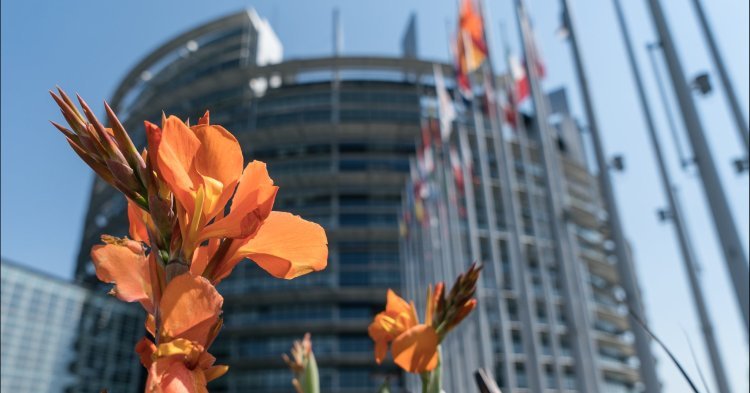Despite nationalist parties across Europe jumping on EU institutions’ lack of democracy to bolster their electorate, pro-European parties have yet to fully seize themselves of this topic and advance concrete solutions to strengthen European democracy. Among the few proposals put forward, however, one seems to have become a topic of lingering discussion — even negotiation — in Brussels: transnational lists for European elections.
Voted down by the European Parliament itself in February 2018 and receiving only lukewarm support from the European Council [1], this reform remains a key proposal for Emmanuel Macron. It was later supported by Angela Merkel and more recently alluded to by Ursula von der Leyen in her speech to the Parliament. [2]
Yet, what may seem like a no-nonsense way to promote a “more European” Europe is, upon closer examination, unlikely to make our elections and politics more integrated. Even worse, it would actively reinforce the national character of European elections, benefit larger countries, and undermine further reform attempts. The ills transnational lists seek to remedy are real, but the solution lies elsewhere.
The false promise of transnational lists
The appeal of transnational lists stems from two misconceptions. The first one is a drastic underestimation of the survival instinct of national parties.
Despite European parties sitting in the European Parliament, or the drafting of electoral manifestos by these Europarties, or even the nomination of Spitzenkandidaten to lead electoral campaigns across Europe, national parties remain firmly in control of European elections. National parties choose candidates, draft electoral programmes, decide on political alliances, spend money, go on the campaign trail, are interviewed and talked about, get elected, are reimbursed for their campaign expenses, and, once elected, join this or that European party.
Unless actively pushed to do so through incentives and constraints, national parties will work hard to maintain their predominance over the EU’s political life. Creating a short list comprising candidates of different nationalities won’t change the core of the campaigns, nor those who run them. At best, we may expect citizens to see the names of Europarties more often, but national parties will remain at the helm — through the drafting of electoral programmes and the selection of national and transnational candidates — and continue to be the visible part of the campaign.
The second misconception concerns the role of the legislature and of the executive, and their relationship to citizens. The legislature’s paramount role is to propose, discuss and adopt the law. As such, it must reflect the diversity of the electorate at the local level and be as close as possible to the citizens; this is why most national parliaments are elected locally.
Despite not possessing the right to legislative initiative, the European Parliament — and European citizens — would gain from MEPs being closer to citizens, and better understanding and representing their interests. By contrast, the executive provides the impetus for government action and acts for all citizens. As such, the choice of the executive must stem from the entirety of the electorate, either directly or indirectly.
Therefore, the proper way to make our political system more European is not to maintain a nation-based system and provide for a small dose of “cross-nation” representation in the legislature. Instead, we must go well beyond the nation-state — both above and below — by electing our representatives at the local level and our executive at the European level. For the European Parliament, a true “European perspective” actually means a “uniform local perspective throughout Europe”.
But transnational lists are not simply a false promise of a more European system – they actively carry risk for our European democracy.
The risks of transnational lists
One could argue that transnational lists “can’t hurt” and that, should they fail to push for more European democracy, we may still gain from their adoption.
However, transnational lists carry at least three distinct risks. The first such risk is to entrench and reinforce the current political system dominated by national parties. Just as the choice of national candidates or of Commissioners is left to national parties and governments, it can only be expected that the candidates on transnational lists will be proposed and selected by national parties.
This would give them even more power and subvert the intent behind transnational lists: citizens would vote for a transnational list as a way to vote for their national party’s candidate, and not based on a more European affiliation.
Secondly, transnational lists will directly strengthen the largest countries and parties. Even claims of quotas and limitations to ensure geographical representation — which, ironically, reintroduce a national perspective — are not reassuring. Since the vote is proportional, only the first candidates of each list truly matter. And just as the current choice of a political group’s leader or of a party’s Spitzenkandidat is the result of bargaining between national parties, [3] the largest national delegations of each Europarty can be expected to reap the highest positions.
Applying the results of the 2019 elections to the composition of Europarties shows that Germany stands to gain 5 seats from transnational lists, France and Spain 4, the UK, Italy and Romania 3, and Poland 2 — meaning that the seven most populous states would seize at least 24 of the proposed 27 seats of transnational lists. [4]
Finally, and probably even more worryingly, by achieving some reform of European elections, transnational lists are likely to diffuse any pressure on politicians for a more thorough reform and for a more effective European democracy. Therefore, not only would transnational lists not make the political system more European, but they would most likely stymie electoral reform for years to come.
European parties are the way forward
Transnational lists for the European Parliament are not likely to make our European campaigns and elections more European, and actually risk deteriorating our electoral process. Yet, this should not come as a surprise, as not a single federal system around the world has felt the need to create them.
However, the creation of a true political union is not out of reach. As Guy Verhofstadt and other MEPs recognise in a 2018 joint tribune, all true federal systems have integrated political parties. The Spinelli Group, a federalist group of which Guy Verhofstadt is a founder, agrees, stating that “democracy in Europe requires real political parties at European level competing with each other for votes and seats.”
The first step in democratising the European Union is to realise that, while the EU currently has a unique political structure — more integrated than confederations, less integrated than federations —, it doesn’t exist separately from the rest of political entities. All political systems and all federal models are unique, but they can and must learn from each other.
Therefore, the habit of calling the EU a “sui generis” entity, in order to avoid any useful comparison with other political systems is both nonsensical and counterproductive. Instead, let us indeed look at the political systems of large democratic federations — such as the United States, India or Brazil — which can provide useful insight.
Potential for pan-European parties
Despite minor policy differences and lines of fracture on specific issues, the political spectrum of most European countries is, by and large, very similar. Most countries possess right-wing/conservative, left-wing/socialist, centre-right/liberal, centre-left/progressive, green, extreme-right/nationalist and extreme-left/communist/anti-capitalist parties.
Variations abound, especially with countries facing specific issues such as regional self-determination, but the standard template remains the same. This is why — despite conflicting policy positions between parties — electoral alliances in the European Parliament have been rather straightforward and stable over time.
A reasonable path for the creation of true European parties is the progressive integration of national parties into a common structure, adopting the same name, logo and, eventually, political programme. Country-based policy differences could persist for national-level issues, but overall coherence would increase and party structures would become integrated.
Such true European parties, without the need for transnational lists, would be able to present a single electoral programme for European elections — a programme that would need to address all European citizens — and organise EU-wide primaries for the election of their lead candidate. This primary, unlike a vote for a transnational list, would allow party members to truly have a say for their candidate to the presidency of the European Commission — and thereby avoid the regular scenario of electing Spitzenkandidaten unknown to the general public and, at best, introducing them to voters during the campaign.
The emergence of such parties requires a review of the current statutes of European political parties, in particular to define them as parties — and not, as currently the case, as cooperations of national parties. The statutes should also provide for cross-border conduct of elections, general assemblies and funding, as well as for the necessary EU-level oversight of these European parties and of their national branches — just like national bodies currently oversee national parties and their local branches.
Pan-European parties in practice
Interestingly, and despite the rise of nationalist parties, 2019 marked the first time a transnational party won a seat in the European Parliament, with Volt’s Damian Boeselager winning a seat in Germany. Still small on national scenes, Volt was created directly as a European entity with national chapters.
This example shows that European-wide parties are not just wishful thinking. They can be a reality, provided there be a willingness to set them up. So far, national parties have resisted this integration into European structures, and it is likely that the mere introduction of transnational lists would fail to create integrated parties.
A surer way for the creation of real European parties is the creation of incentives and constraints. Incentives should include specific financing for integrated European parties and a facilitation of their operations. Constraints should include the necessity to run campaigns under — and only under — the name and logo of European parties. Such changes would progressively push national parties to integrate and coalesce at the European level.
Reforming institutions and the electoral system
But real European parties, crucial as they may be, are not the only reform necessary to create a true political Union. Attempts to reform EU institutions and procedures, to increase transparency, to review practices, and to engage citizens, are all essential. In particular, making our election more European requires a profound reform of our electoral system.
For the European Parliament, the idea of a double vote is a sensible one. As for the German Bundestag elections, European citizens should be able to vote for a local candidate standing for a local constituency — with each local constituency across Europe electing one representative.
A second vote, for a true European party, would ensure overall proportionality and draw MEPs from country-wide lists — and not transnational lists, in order to keep them closer to citizens and avoid favouring larger countries.
Of course, as is already the case, all citizens will have the right to stand for elections on either the local or country list, provided they reside in the constituency in question.
Conclusion
Overall, transnational lists give the impression of a European choice. However, they do not provide citizens with more voting power, do not bring representatives closer to the people, do not change who chooses candidates and leads campaigns, and do not lead to a more European message from political parties to citizens. Transnational lists will, however, entrench national politics, favour larger member states, and stifle reform.
In order to achieve real progress, let us humbly take a page from other large federal democracies and have the courage to care first about what must be our paramount goal — the creation of a true European democracy. Even, and especially, if this means dismantling the age-old political structures we have grown accustomed to. This must be the fight of the coming European legislature.


Follow the comments: |
|
